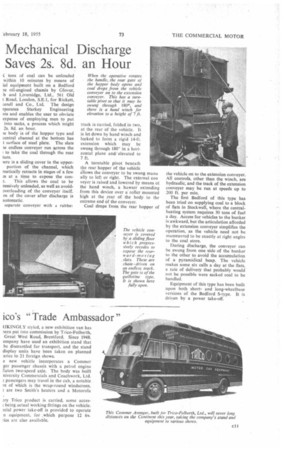Mechanical Discharge Saves 2s. 8d. an Hour
Page 51

If you've noticed an error in this article please click here to report it so we can fix it.
C tons of coal can be .unloaded within 10 minutes by means of iaI equipment built on a Bedford 3e oil-engined chassis by Glover, b and Liversidge, Ltd., 561 Old t Road, London, S.E.1, for Rickett, cerell and Co., Ltd. The design rporates Starkey Engineering nts and enables the user to obviate expense of employing men to put into sacks, a process which might 2$. 8d. an hour.
te body is of the hopper type and central channel at the bottom has t surface of steel plate. The slats le endless conveyer run across the to take the coal through the rear lure.
sere is a sliding cover in the upperportion of the channel, which matically retracts in stages of a few n at a time to expose the con r, This allows the coal to be ressively unloaded, as well as avoidDirerloading of the conveyer itself. m of the cover after discharge is automatic.
separate conveyer with a rubber
track is carried, folded in two, at the rear of the vehicle. It is let down by hand winch and locked to form a rigid 14-ft. extension which may be swung through 180° in a horizontal plane and elevated to 7 ft.
A turntable pivot beneath the rear hopper of the vehicle allows the conveyer to be swung manu ally to left or right. The external con veyer is raised and lowered by means ot the hand winch, a hawser extending from this device over a roller mounted high at the rear of the body to the extreme end of the conveyer.
Coal drops from the rear hopper of the vehicle on to the extension conveyer. All controls, other than the winch, are hydraulic, and the track of the extension conveyer may be run at speeds up to 200 ft. per min.
The first Bedford of this type has been tried on supplying coal to a block of flats in Stockwell, where the centralheating system requires 30 tons of fuel a day. Access for vehicles to the bunker is awkward, but the articulation afforded by the extension conveyer simplifies the operation, as the vehicle need not be manceuvred to be exactly at right angles to the coal store.
During discharge, the conveyer can be swung from one side of the bunker to the other to avoid the accumulation of a pyramidical heap. The vehicle makes some six calls a day at the flats, a rate of delivery that probably would not be possible were sacked coal to be handled.
Equipment of this type has been built upon both shortand long-wheelbase versions of the Bedford S-type. It is driven by a power take-off.








































































































